David Price Would Offer Dodgers More Name Recognition Than Certainty
As rumors of the various permutations of Mookie Betts trades float around the ether, it’s worth taking a closer look at the Dodgers’ rotation, mainly because of the possibility that David Price is included in what would become an even bigger blockbuster than a “simple” trade of one of the majors’ top five players. Despite losing both Hyun-Jin Ryu and Rich Hill in free agency, the Dodgers don’t lack for options to start, many of them good ones. But between inexperience and injury histories, those options also offer a great deal of uncertainty, and it’s not at all clear that the 34-year-old Price, whose performance has declined of late and who comes with his own recent spate of health woes, helps all that much.
Last year, the Dodgers had by far the NL’s best rotation in terms of ERA and FIP, though they finished behind the Nationals — whose starters ranked second in both categories — in WAR, because the Washington workhorses threw significantly more innings:
| Team | IP | K/9 | BB/9 | HR/9 | BABIP | ERA | FIP | WAR |
|---|---|---|---|---|---|---|---|---|
| Dodgers | 893.2 | 9.45 | 2.07 | 1.13 | .274 | 3.11 | 3.52 | 19.8 |
| Nationals | 938.2 | 9.68 | 2.86 | 1.11 | .288 | 3.53 | 3.72 | 21.4 |
By itself, the Dodgers’ lower innings total doesn’t matter, but the loss of Ryu, whose 182.2 innings were the most by any Los Angeles starter since 2015, leaves the team with only three pitchers who threw at least 100 innings last year, namely Walker Buehler (30 starts, 182.1 innings), Clayton Kershaw (28 starts, 178.1 innings), and Kenta Maeda (26 starts, 153.2 innings), the last of whom spent all of September in the bullpen and has been mentioned in at least one version of the Betts trade. Read the rest of this entry »



